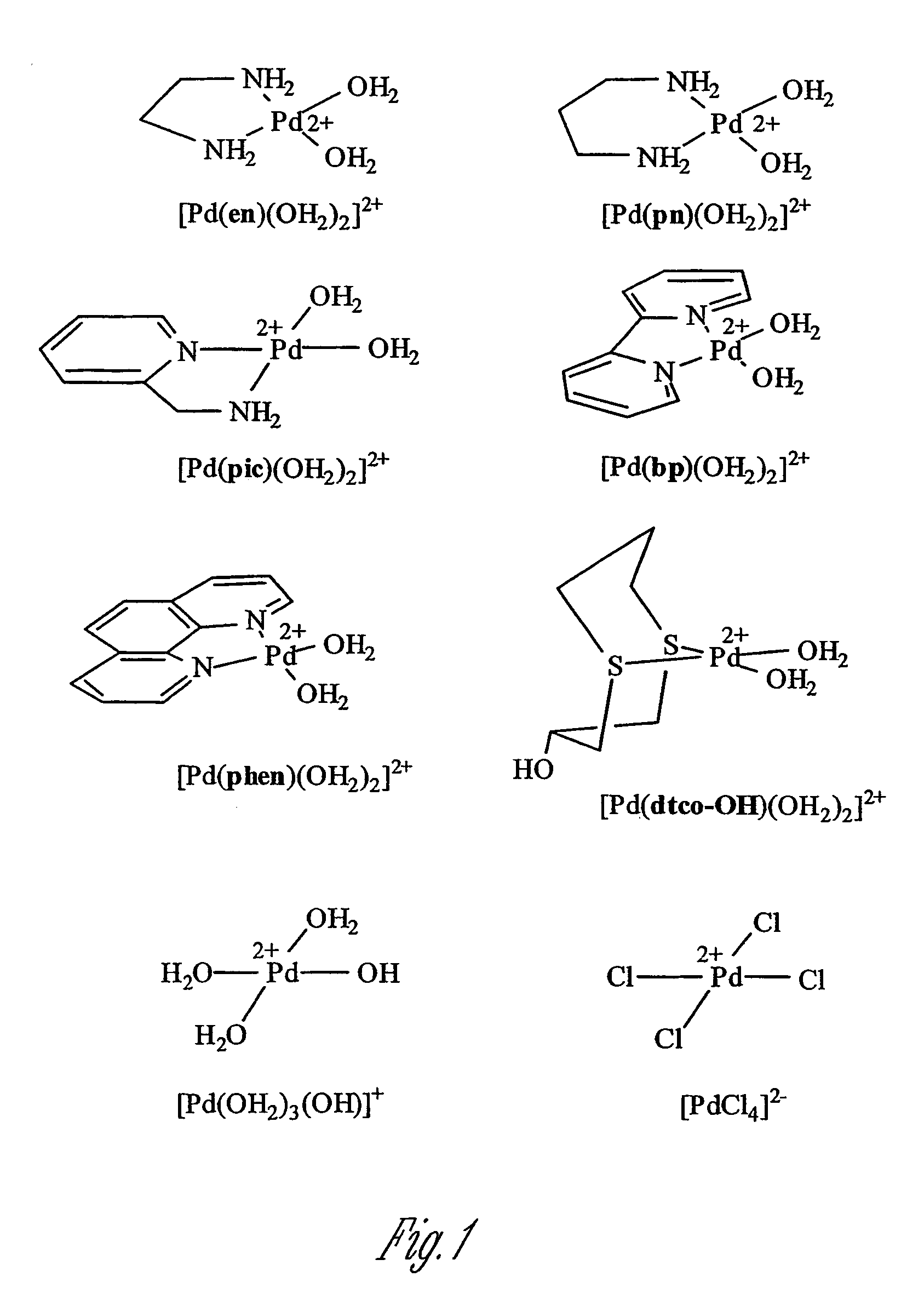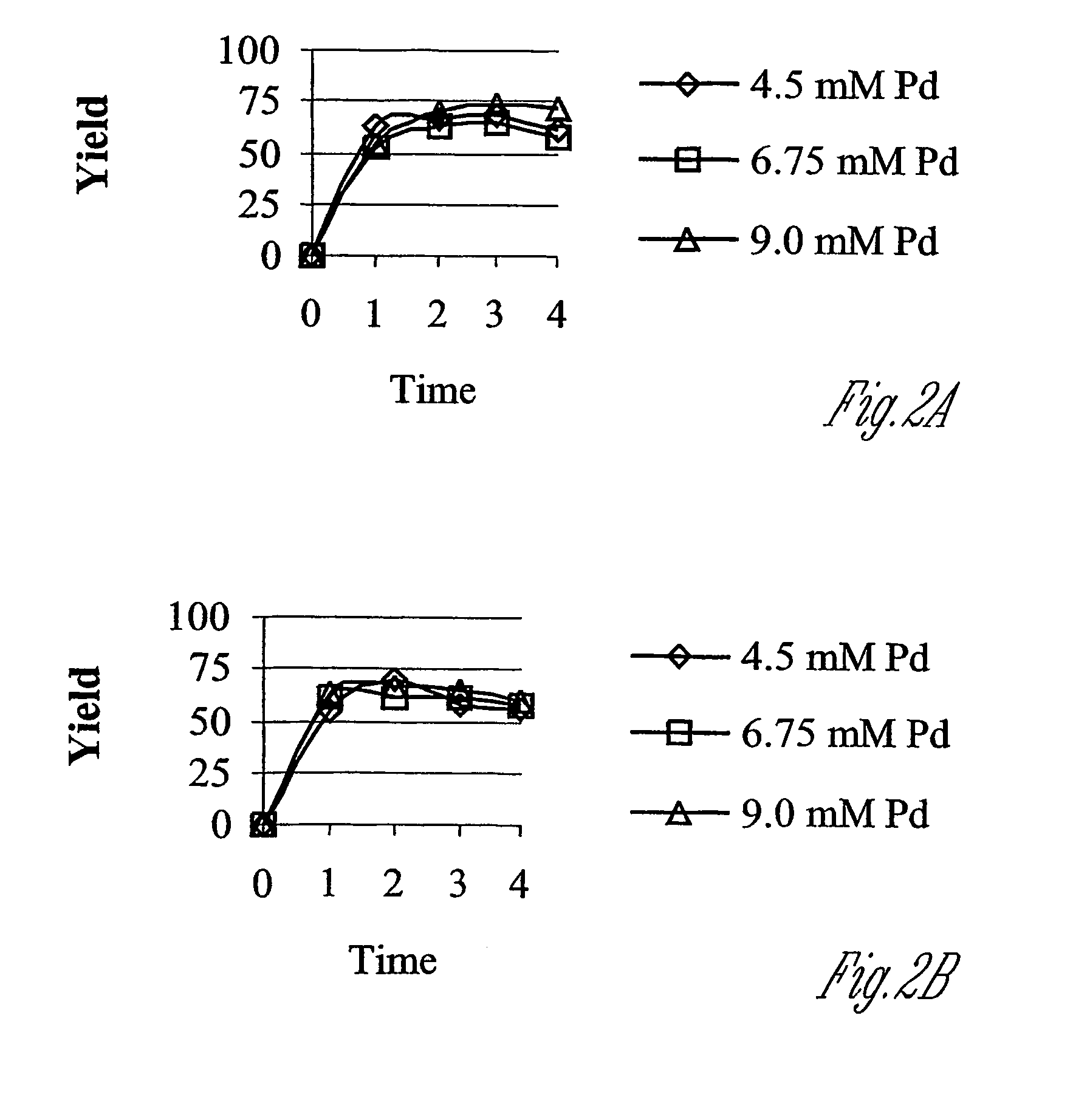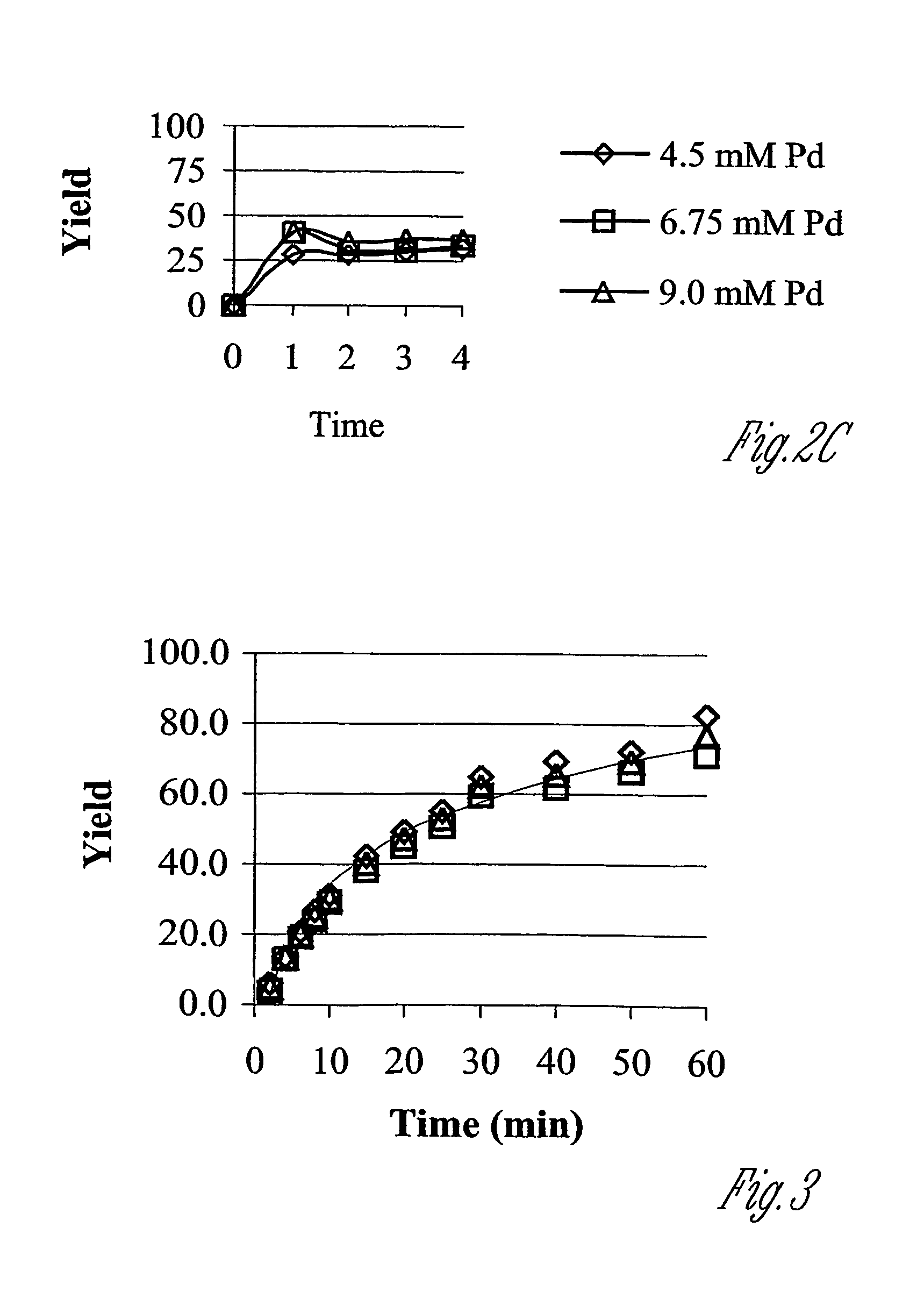Polypeptide cleavage process
a polypeptide and cleavage technology, applied in the field of polypeptide cleavage process, can solve the problems of partial or complete loss of peptide, inconvenient method, technique failure, etc., and achieve the effect of promoting acid cleavag
- Summary
- Abstract
- Description
- Claims
- Application Information
AI Technical Summary
Benefits of technology
Problems solved by technology
Method used
Image
Examples
example 1
Preparation of GRF(1-44)Ala
[0047]1. Preparation of Palladium Cleavage Promoters p Palladium(II) complexes were prepared as follows. Na2PdCl4, cis-[Pd(en)Cl2], cis-[Pd(bp)Cl2] and cis-[Pd(phen)Cl2] were purchased from Aldrich Chemical Co. and Strem Chemical Co. cis-[Pd(pn)Cl2] (H. Hohmann et al., Inorg. Chim. Acta, 174: 87 (1990)), cis-[Pd(pic)Cl2] (T. Rau et al., Inorg. Chem., 36: 1454 (1997)) and cis-[Pd(dtco-OH)Cl2] (C. Drexler et al., Inorg. Chem., 30: 1297 (1991)) were prepared essentially as described in the references. The complexes with aqua ligands, cis-[Pd(en)(OH2)2]2+, cis-[Pd(pn)(OH2)2]2+, cis-[Pd(pic)(OH2)2]2+, cis-[Pd(bp)(OH2)2]2+, cis-[Pd(Phen)(OH2)2]2+, and cis-[Pd(dtco-OH)(OH2)2]2+, were obtained as the nitrate salt by treating each corresponding complex with 1.98 equivalents of AgNO3 in water. The complex [Pd(OH2)3(OH)](NO3) in solution was obtained by stirring a mixture of K2PdCl4 and 3.98 equivalents of AgNO3 for 2 hr at 50° C.
example 2
Production of a Derivative of Recombinant Human Growth Hormone Releasing Factor (rRF-CH)
[0066]1. Expression of the T7tag-Vg-D4K-CH-GRF(1-44)-CH (SEQ ID NO:6) Precursor peptide:
[0067]T7tag-Vg-D4KCH-GRF (1-44)-CH (SEQ ID NO:6) FIG. 6) was recombinantly expressed in E. coli in accordance with techniques analogous to those disclosed for the expression of rGRF-Ala in Example 1.
[0068]2. Solubilization And Cleavage Of T7tag-Vg-D4K-CH-GRF(1-44)-CH (SEQ ID NO:6)
[0069]a. Analytical Methods
[0070]The following analytical methods and devices were used. The Microsorb-MV CNC8 reverse-phase HPLC method used a Microsorb-MV Cyano-C8 100 Å, 5 μm, 4.6×150 mm column. The mobile phase system was as follows: A=5% (v / v) acetonitrile, 0.1% (v / v) trifluoroacetic acid; B=95% (v / v) acetonitrile, 0.1% (v / v) trifluoroacetic acid. The gradient used to quantitate the IB sample, (t=0 hours) was as follows: 10-100% B (10.8 min.), 100% B (0.6 min.), 100-10% B (0.6 min.) at 1 ML / min at ambient temperature. The gradien...
example 3
1. Solubilization and cleavage of T7tag-Vg-D4K-CH-GRF(1-44)-CH (SEO ID NO:6)
[0075]The solubilization and cleavage of T7tag-Vg-D4K-CH-GRF(1-44)-CH (“CH precursor peptide”) (SEQ ID NO:6) in 80% formic was studied. A matrix of conditions was designed in which formic acid concentration and tetrachloropalladate concentrations were varied to find optimal conditions of cleavage of this precursor peptide The precursor peptide was homogenized using the plastic probe and the OMNI 5000 high-sheer homogenizer set to solubilize to approximately 5 mg / mL or 0.45 mM precursor peptide. After solubilization, a sample of each solution was taken as a t=0 hr time point which was used to determine the 100% theoretical cleavage yield. Tetrachloropalladate at 4.5, 6.75 and 9 mM was used and the cleavage monitored by HPLC with time points taken every hour. The reactions were done at 60° C. The time points were diluted six-fold with 48 mM thiourea (40 mM final thiourea). All analytical analyses were done as ...
PUM
| Property | Measurement | Unit |
|---|---|---|
| temperature | aaaaa | aaaaa |
| cleavage reaction temperature | aaaaa | aaaaa |
| molecular weight | aaaaa | aaaaa |
Abstract
Description
Claims
Application Information
 Login to View More
Login to View More - R&D
- Intellectual Property
- Life Sciences
- Materials
- Tech Scout
- Unparalleled Data Quality
- Higher Quality Content
- 60% Fewer Hallucinations
Browse by: Latest US Patents, China's latest patents, Technical Efficacy Thesaurus, Application Domain, Technology Topic, Popular Technical Reports.
© 2025 PatSnap. All rights reserved.Legal|Privacy policy|Modern Slavery Act Transparency Statement|Sitemap|About US| Contact US: help@patsnap.com



